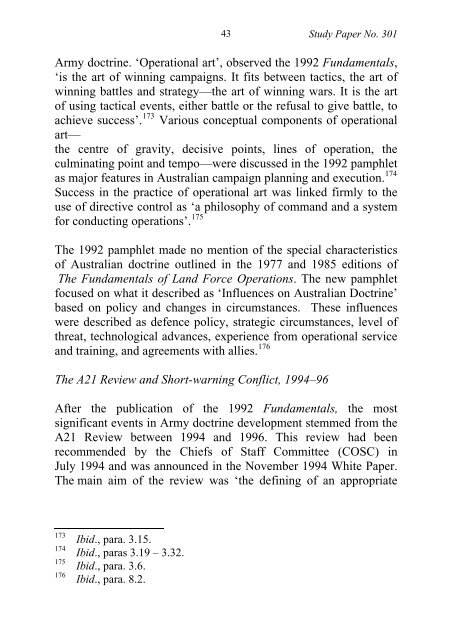Ibid - Australian Army
Ibid - Australian Army
Ibid - Australian Army
You also want an ePaper? Increase the reach of your titles
YUMPU automatically turns print PDFs into web optimized ePapers that Google loves.
43<br />
Study Paper No. 301<br />
<strong>Army</strong> doctrine. ‘Operational art’, observed the 1992 Fundamentals,<br />
‘is the art of winning campaigns. It fits between tactics, the art of<br />
winning battles and strategy—the art of winning wars. It is the art<br />
of using tactical events, either battle or the refusal to give battle, to<br />
achieve success’. 173 Various conceptual components of operational<br />
art—<br />
the centre of gravity, decisive points, lines of operation, the<br />
culminating point and tempo—were discussed in the 1992 pamphlet<br />
as major features in <strong>Australian</strong> campaign planning and execution. 174<br />
Success in the practice of operational art was linked firmly to the<br />
use of directive control as ‘a philosophy of command and a system<br />
for conducting operations’. 175<br />
The 1992 pamphlet made no mention of the special characteristics<br />
of <strong>Australian</strong> doctrine outlined in the 1977 and 1985 editions of<br />
The Fundamentals of Land Force Operations. The new pamphlet<br />
focused on what it described as ‘Influences on <strong>Australian</strong> Doctrine’<br />
based on policy and changes in circumstances. These influences<br />
were described as defence policy, strategic circumstances, level of<br />
threat, technological advances, experience from operational service<br />
and training, and agreements with allies. 176<br />
The A21 Review and Short-warning Conflict, 1994–96<br />
After the publication of the 1992 Fundamentals, the most<br />
significant events in <strong>Army</strong> doctrine development stemmed from the<br />
A21 Review between 1994 and 1996. This review had been<br />
recommended by the Chiefs of Staff Committee (COSC) in<br />
July 1994 and was announced in the November 1994 White Paper.<br />
The main aim of the review was ‘the defining of an appropriate<br />
173<br />
174<br />
175<br />
176<br />
<strong>Ibid</strong>., para. 3.15.<br />
<strong>Ibid</strong>., paras 3.19 – 3.32.<br />
<strong>Ibid</strong>., para. 3.6.<br />
<strong>Ibid</strong>., para. 8.2.

















